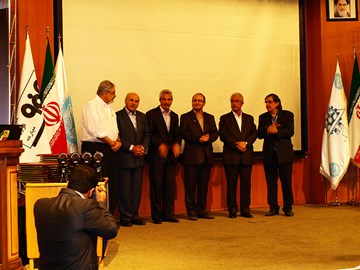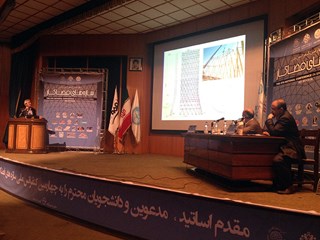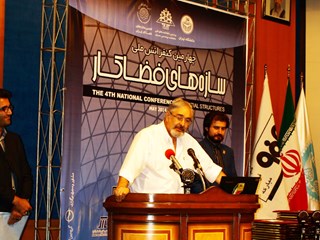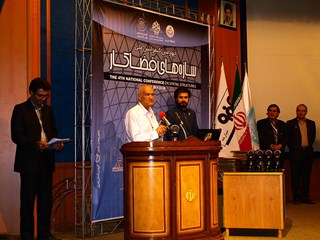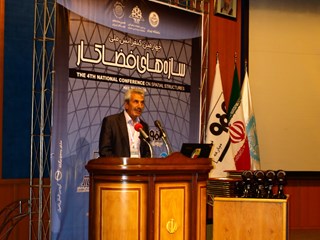همزمان با چهارمین كنفرانس ملی سازه های فضاكار در روز 3 خرداد دو کارگاه تخصصی سازه های فضاكار شامل طراحی و تحلیل و ملاحظات معماری برگزار شد. آقایان دکتر محمود هریسچیان، دکتر نصراله دیانت، دکتر شاهرخ مالک دکتر کریم عابدی و دکتر مهدی مقیمی به عنوان مدرس در این دو کارگاه شرکت داشتند.
چهارمین كنفرانس ملی سازه های فضاكار در تاریخ 4 و 5 خرداد 1393 توسط دانشكده فنی دانشگاه تهران و انجمن علمی سازه های فضاكار ایران در محل دانشكده فنی دانشگاه تهران برگزار شد. در چهارمین كنفرانس ملی سازه های فضاكار استادان برجسته سازه های فضاكار از جمله پروفسور هشیار نوشین (استاد سازه های فضاكار دانشگاه ساری انگلستان) به عنوان رئیس افتخاری کنفرانس و پروفسور مارکار گریگوریان به عنوان مهمان ویژه شرکت داشتند. شرکت سازه های افق نور (سان) به عنوان یکی از حامیان این کنفرانس (چهارمین كنفرانس ملی سازه های فضاكار) در این همایش شرکت داشت. همچنین مقالات مختلفی بوسیله استاد هشیار نوشین، دکتر محمود هریسچیان و همکاران ایشان در مورد فرم شناسی سازه های فضاكار، مدلسازی و تحلیل سیستم های سازه های فضاكار، پیونده ها، کمانش وپایداری سازه های فضاكار، ارائه گردید.
خلاصه ای از این مقالات در ادامه ذکر گردیده است:
H Nooshin H, Samavati OA. Exploring the Concept of Novation. Fourth National Iranian Conference on Spatial Structures, May, 2014.
Abstract: ‘Configuration processing’ is the branch of knowledge that deals with the concepts and software necessary for generation and processing of geometric configurations. ‘Formex algebra’ and its programming language ‘Formian’ provide a convenient environment for configuration processing of all kinds. Architects and structural engineers working with structural forms are among experts in many different disciplines that benefit from configuration processing concepts and tools.
The objective of the present work is to explore the capabilities of a particular configuration processing concept that is referred to as ‘novation’. The concept of novation is implemented as a ‘function’ in Formian. This function is an effective configuration processing tool. In particular, the function provides a powerful conceptual aid for creation of freeform configurations.
In this paper, the emphasis is on the practical considerations and guidance for processing of forms rather than involvement in details of the mathematical theory. The paper contains many examples providing an overall view of the capabilities of the novation function.
Heristchian M, Nooshin H, Pourakbar P. The Ultimate Strength of Hexa-node for Double-Layer Lattice Cooling Towers. Fourth National Iranian Conference on Spatial Structures, May, 2014.
Abstract. The paper studies the ultimate strength of Hexa-node, the structural node used in the construction of a number of double-layer funnel lattice steel cooling towers in Iran. Understanding the ultimate and the working strength and stiffness of the possible connections is required for the design of a spatial structure. Comparison of numerical modelling with the experimental results is the most useful method to investigate the structural behaviour of the joints. The geometry and proportions of a particular connection depends on various factors such as the magnitude of forces, the size of the structural members, the end-details of the elements, the method of construction and economic factors. Considering various factors, hexa-node was selected for the design of a number of lattice steel cooling towers. The numerical modelling is used to obtain the structural strength of the hexa-node with Abaqus 6.10-1. Several multi-directional load conditions that could occur during the life-time of the tower were considered in obtaining the load-displacement diagrams of the hexa-node.
Grigorian M, Maalek S, Heristchian M. New Displacement Theorem and Methodology for the Efficient Design of Flexural Grids and Double Layer Trusses. Fourth National Iranian Conference on Spatial Structures, May, 2014.
Abstract: While Allowable stress is still the predominant design methodology for flexural and double layer articulated grids and similar structures under service conditions, Performance control (PC) could further enhance their functional uses up to plastic limit states. PC is a recently developed, observation based, design process that aims at rational and efficient selection of structural elements rather than investigating their usefulness through iterative processes. The proposed methodology is ideally suited for preliminary design as well as capacity analysis purposes. It lends itself well to manual, spreadsheet as well as electronic computations. The basic notion behind PC is that structural response is mainly a function of design and detailing, rather than numerical computations. The design concept uses pre-selected target displacements and failure mechanisms as key control objectives. The current contribution presents a general technique for the estimation of maximum plastic displacements of twistless, orthotropic, space frames of regular formation, simply supported along the sides of a parallelogram, and subjected to monotonically increasing uniform distribution of normal nodal forces. In the interim a new application for the uniqueness theorem has also been discussed. The applications of the proposed solutions have been illustrated through a number of generic examples.
Heristchian M, Ameri SH, Baghdadi A. Factors Affecting In-plane Buckling Load of Steel Truss Arch Bridges. Fourth National Iranian Conference on Spatial Structures, May, 2014.
Abstract. The present paper studies the effect of various factors on the buckling behaviour and load carrying capacity of the steel arch truss bridges. Over three hundred fifty arch trusses are modelled, in Abaqus 6.10.1, and the efficiency of truss pattern, boundary condition, connection type, deck level, rise-to-span ratio, truss depth and the arrangement of the hangers are investigated. All of these parameters significantly affect the buckling behaviour of arch trusses. Inclusion of web elements in the radial direction, together with web bracings, significantly increases the capacity of the arch trusses. However, the rigidly jointed arch trusses (with only radial web elements), have poor capacity. Having double supports (for both top and bottom chords) nearly doubles the capacity of the arch. Position of the deck in half-through type bridges, at ½ height of the arch, results in more pronounced effect on increasing its strength. Taking into account the material nonlinearity in addition to the geometric nonlinearity dramatically decreases the load carrying capacity of the arch trusses.
Heristchian M, Baghdadi A, Ameri SH. Elastic and Plastic Buckling of Steel Arches under In-plane Loadings. Fourth National Iranian Conference on Spatial Structures, May, 2014.
Abstract. The paper studies the buckling behaviour of steel arches under vertical in‐plane loadings. The arches have uniform rectangular sections and their shapes are defined by various mathematical functions. The shapes of some of these arches are frequently encountered in bridge or other ancient constructions built with masonry materials. The study includes the effect of change in height‐to‐span ratios for the range (0.01, 0.5), with a constant span and fixed end-supports. The stability analyses include both linear and nonlinear steel materials. For the box section under study and for most of the designed sections in arch bridges, plastic buckling could occur earlier than elastic buckling. The studies show that the buckling behaviour of the arch varies with its shape. The results indicate that each arch type should be utilized in a dedicated particular situation for the optimization of the structure.
Heristchian M, Zandi O. The Strength and Stiffness of the Paraboloidal Single-Layer Lattice Steel Cooling Towers with Stiff Rings. Fourth National Iranian Conference on Spatial Structures, May, 2014.
Abstract. The paper compares the effect of the stiff rings on the structural behaviour of a paraboloidal single-layer lattice steel cooling tower. In arid and earthquake prone countries such as Iran, steel lattice cooling towers with ‘dry’ cooling system, are more advantageous than concrete cooling towers due to having much lower relative weights. For ‘light’ steel cooling towers then, wind load is one of the most important determining design loads. The paper therefore, focuses on the study of the structural behaviour of cooling towers under wind load. The mechanical and operational factors determine the general dimensions of a cooling tower. The addition of stiff rings has a decisive role in reduction of forces and displacements of the single-layer lattice cooling towers. The effect of the type and number of stiff rings, their depth and position within the height of the tower, on the stiffness and strength of a tower are studied. Stiff rings significantly improve the overall stability of the tower. The addition of three stiff rings to the tower, for the studied conditions, reduced the maximum horizontal displacements and forces of the tower over 90%, and 60%, respectively.
Babaei M, Sheidaii MR, Heristchian M. Desirability based design of space structures using soft-computing. Fourth National Iranian Conference on Spatial Structures, May, 2014.
Abstract. Engineering design usually requires considering multiple variances in a design and integrating them appropriately in order to achieve the most desirable alternative. This consideration takes particular importance in the constructional projects of civil engineering. However, frequently, the structural designer’s considerations in civil engineering teams contrast the stylish and creative novelties of architectures. Then, we should take up new methodologies to yield appropriate alternatives which meet artistic aspects of design and simultaneously satisfy the structural designer’s demands. Consequently, the process of design should incorporate the multi-fold aspects of engineer’s requirements and their personal preference. So, in this study, we preset a systematic approach, so-called desirability based design, to perform a directed multi-objective optimal design considering various aspects of a design, based on soft-computing methods. Fuzzy logic integrated with genetic algorithm is employed to build a decision-making fuzzy system based on expert knowledge. It will be employed to conduct the designing process. An illustrative example show practicality of the presented methodology in structural design of space structures.

